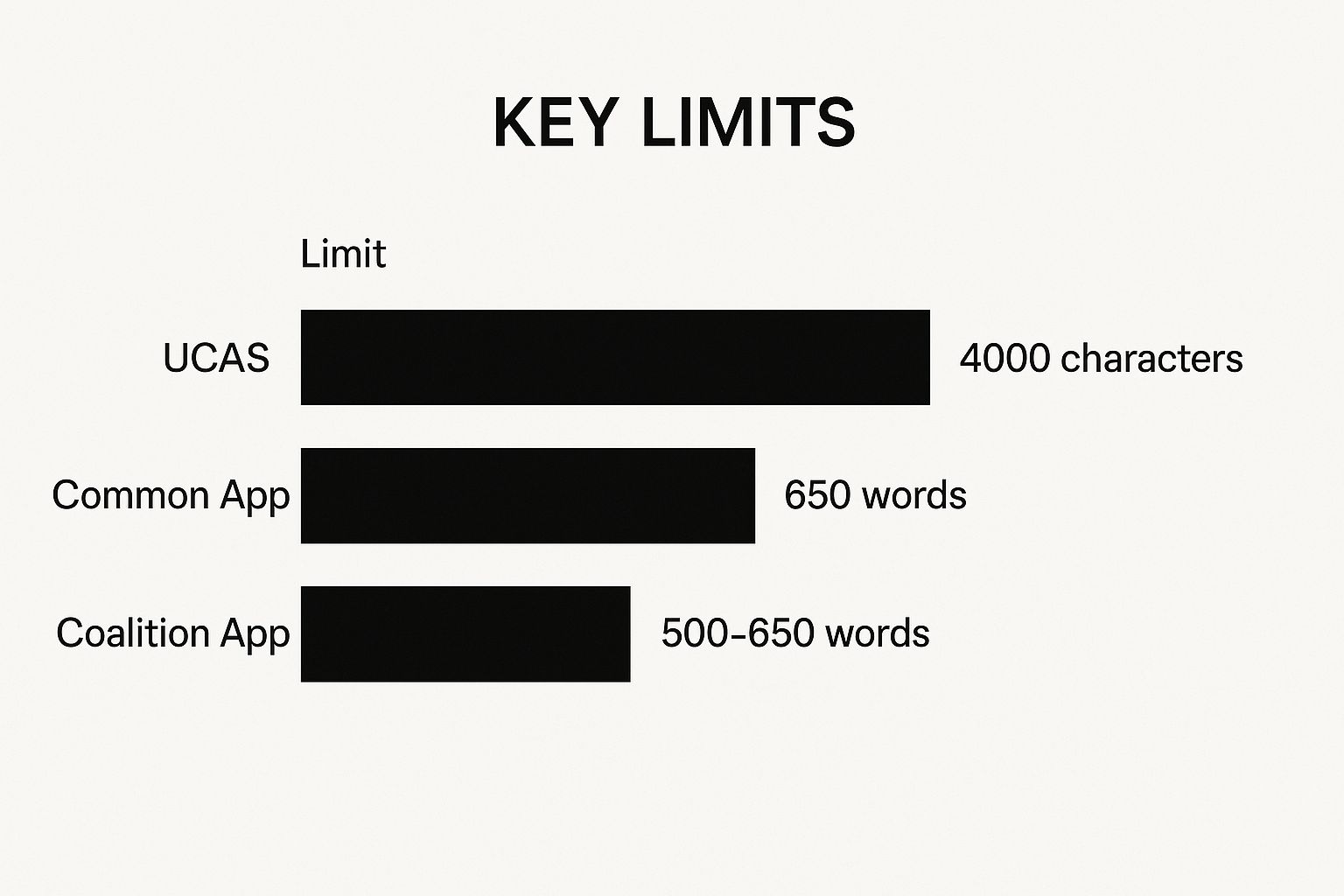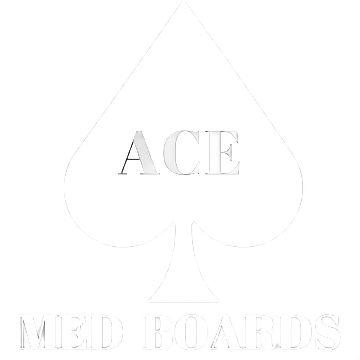When you're asking, "how many words should my personal statement be?" the answer really depends on which application system you're using. These platforms aren't just being difficult; their limits are a test of your ability to be clear and concise.
For instance, the AMCAS medical school application gives you a 5,300-character limit, which comes out to roughly 850 words. On the other hand, the Common App for undergrads caps you at 650 words. The first step is always to check the specific guidelines for the platform you're using.
Your Guide to Personal Statement Word Counts
Think of the word or character limit as a puzzle. Your job is to fit your unique story perfectly within the space provided. Going over means your essay gets awkwardly cut off, but falling too far short can make it seem like you don't have enough to say.
Nailing these limits is a non-negotiable part of the application process. Admissions committees use them to see if you can follow directions and present a powerful argument without rambling.
The image below gives you a quick visual comparison of the length requirements for a few major application platforms.

As you can see, the rules vary quite a bit, from a strict character count to a more flexible word range. This is exactly why you can't just write one essay and send it everywhere; you have to tailor it for each specific application. This same kind of question pops up in other fields, too, like in digital marketing where experts debate how many specific elements are optimal for the best results.
For a deeper dive into making every single word count, check out our complete guide on https://acemedboards.com/how-to-write-personal-statement/. It’ll give you the framework you need to build a compelling narrative that fits perfectly within the rules.
Why Word Counts Matter More Than You Think

It’s tempting to view those strict character limits as just another administrative hurdle. But in reality, they’re your very first test. Think of your personal statement as a movie trailer for your future career in medicine—it has to be compelling and impactful, leaving the admissions committee eager to see the full feature. All within a very tight runtime.
Going over the limit isn't an option. Most application systems will just unceremoniously chop off your story mid-sentence. On the other hand, staying too far under the limit can signal a lack of substance or effort. Sticking to the word count is a direct reflection of your ability to follow instructions, a non-negotiable skill for any physician.
A Test of Precision and Focus
Beyond just following the rules, the word count is a challenge of professional communication. Can you distill years of complex experiences, motivations, and personal growth into a clear, powerful narrative? This isn't just a writing exercise; it's a fundamental clinical skill. Every single day, doctors have to convey critical information to patients and colleagues with precision and clarity.
Your personal statement is the first real evidence you can provide of this competency. When an admissions officer reads a concise, well-crafted essay, it tells them you know how to organize your thoughts and present a focused case for your candidacy.
The reality is, your statement has a tiny window to make an impression. A recent study found that nearly 40% of graduate admissions officers spend five minutes or less on each one. This highlights just how critical brevity and immediate impact are. You can find more insights in this detailed report on personal statement statistics.
Ultimately, if you can learn to see the word count as a framework for excellence rather than a barrier, your entire approach will shift. It’s a structure designed to help you showcase your focus and professionalism, proving from the very first page that you’re ready for the rigors of medical school.
Navigating Medical School Application Limits

When you're applying to medical school, the first thing to understand is that the rules for each application service are non-negotiable. These platforms don't care about your word count; they measure your personal statement in characters. It’s a strict format that demands precision from the moment you start writing.
This isn't just a minor detail—it shapes your entire approach. Getting this wrong means your carefully crafted conclusion could get chopped off mid-sentence.
The major services have similar, yet slightly different, requirements. Knowing these numbers is your first step.
Core Application Character Limits
Here’s a quick breakdown of what you’re working with for the main U.S. medical school application platforms:
- AMCAS (MD Programs): You get a maximum of 5,300 characters. This includes every letter, space, and punctuation mark.
- AACOMAS (DO Programs): This service also sticks to a firm 5,300-character limit.
- TMDSAS (Texas Programs): If you're applying through this system, you have a bit less room to work with: a 5,000-character limit.
So, what does that look like? These character counts usually translate to somewhere between 800 and 900 words. But don't get too comfortable thinking in words; the character limit is the only number that truly matters. A good way to visualize the space is about one and a half single-spaced pages.
This framework forces you to build a tight, compelling narrative. You have to tell a complete story with a clear beginning, middle, and end, making sure every single sentence earns its spot and pushes your argument for acceptance forward.
Forcing a concise narrative is a classic admissions challenge. For example, the Common App personal statement limits applicants to 650 words and practically begs for a three-part structure—challenges faced, actions taken, and lessons learned—to create a clear arc. With admissions officers spending just a few minutes on each essay, getting to the point is everything.
Effectively using this limited space is a skill in itself. If you're looking for inspiration on how to tell a powerful story within these constraints, check out this sample personal statement for medical school to see how it's done.
So, How Long Should My Residency Personal Statement Be?

Alright, you’ve made it through med school applications, and now you’re staring down residency. The game changes here, especially when it comes to the personal statement. If you're applying through the Electronic Residency Application Service (ERAS), you get a lot more room to work with.
ERAS gives you a hard limit of 28,000 characters, which includes every single letter, space, and comma. This usually works out to somewhere between 700 and 850 words—basically a full, single-spaced page. That's a big jump from your med school essay, but don't get the wrong idea. This extra space is a test of your maturity and focus, not an invitation to ramble.
Don't Just Add More—Add More Depth
Think of the bigger word count as an opportunity to connect the dots for the program director. They don't need a longer laundry list of your accomplishments; they want to see a more thoughtful, nuanced reflection on your journey. This is where you show them why you've chosen this specialty.
With the extra real estate, you can:
- Go beyond the "what" of your research: Instead of just summarizing your project, talk about the questions that kept you up at night and how your discoveries shaped your clinical thinking.
- Tell a powerful clinical story: Share a detailed anecdote from a rotation that cemented your decision to pursue a specialty. Show them your thought process, your empathy, and how you grew from the experience.
- Paint a clear picture of your future: Explain where you see yourself in five or ten years. Crucially, connect that vision directly back to their program and why it's the perfect place to launch your career.
Your goal here is to prove you're the right fit. The expanded format lets you build a truly compelling case for why you aren’t just a qualified applicant, but the ideal candidate who understands what this specialty demands.
The ERAS statement requires a higher level of synthesis. You need to weave your academic achievements, research projects, and clinical experiences into one cohesive story that points directly toward your future as a resident. Every paragraph you add has to strengthen that core argument and prove you're ready.
To help you map this out, here’s a potential structure to guide your writing. Think of these as flexible guidelines, not rigid rules, to help you allocate your word count effectively.
Structuring Your Personal Statement Within Word Limits
| Section of Statement | Suggested Word Count (AMCAS) | Suggested Word Count (ERAS) |
|---|---|---|
| Introduction/Hook | 75-100 words | 100-125 words |
| "Why Medicine" Foundation | 150-175 words | 175-225 words |
| Clinical/Research Experiences | 150-175 words | 250-300 words |
| "Why This Specialty" & Future Goals | Not applicable | 150-200 words |
| Conclusion/Fit with Program | 75-100 words | 100-125 words |
As you can see, the biggest shift for the ERAS statement is the expanded section on your specific experiences and future goals. This is where you have the space to provide the detail and reflection that program directors are looking for.
How to Edit Your Essay to the Perfect Length
The editing process is where a good personal statement truly becomes great. Let's walk through a hands-on toolkit that will help you shape your essay to the perfect length without sacrificing the power of your story. This is about making sure you know exactly how many words your personal statement needs for maximum impact.
If your first draft is running long, the initial step is to hunt for inefficiencies. Think of it like a surgeon making precise incisions—your goal is to trim the fat from your narrative to make it lean and muscular. Every single word has to earn its spot.
Strategies for Trimming Your Word Count
Start by targeting the usual suspects that add length but not value. These quick fixes can often get you comfortably within the required limits faster than you'd think.
- Eliminate weak adverbs: Words like ‘very,’ ‘really,’ and ‘just’ are often just filler. Cutting them almost always makes a sentence punchier.
- Target passive voice: Sentences written in the passive voice tend to be wordier and less direct. Flip "The sample was analyzed by me" to "I analyzed the sample." It saves words and sounds way more confident.
- Swap wordy phrases: Look for clunky phrases. You can easily replace “due to the fact that” with “because,” or “in order to” with a simple “to.” These small swaps add up.
Still over the limit? It’s time for bigger cuts. Scrutinize your essay for a redundant anecdote or an idea you've already proven elsewhere. Sometimes, removing a story that isn't pulling its weight is the best move you can make, freeing up a huge chunk of space.
For more targeted advice, especially for the ERAS application, our guide on ERAS personal statement length dives deeper into platform-specific strategies.
The goal isn’t just to cut words—it’s to boost clarity and impact. A shorter, more focused statement is always more powerful than a longer one that rambles. Remember, the average personal statement takes three to seven drafts to get right.
How to Add Substance if You're Too Short
Struggling to meet a minimum word count presents a totally different challenge. The answer isn't to add fluffy, empty sentences. It’s to add depth.
Go back to your most important experiences. Ask yourself: have I truly shown their significance?
Instead of just saying you learned about teamwork, describe a specific moment of conflict or collaboration and exactly what you did. Use vivid anecdotes to show your qualities, not just tell the reader you have them.
Many of these principles apply broadly to any compelling application document. For instance, you can find similar valuable guidance on how to make your cover letter stand out. By digging deeper into your key stories, you’ll add meaningful content that makes your narrative stronger and more memorable.
Answering Your Top Questions About Personal Statement Length
When you're pouring your heart and soul into your personal statement, a few nagging questions about the rules always seem to pop up. Let's clear up some of the most common points of confusion so you can focus on telling your story.
How Strict Are The Character Limits, Really?
Think of the character count on application portals like AMCAS as a locked gate. It’s a hard cutoff. If the limit is 5,300 characters, and you type 5,301, the system will chop your essay off mid-sentence. There is zero wiggle room.
When it comes to suggested word counts (for applications that use them), sticking to the limit shows you can follow directions and respect the admissions committee's time—a critical skill for any future doctor.
What Actually Counts Toward The Character Limit?
This is a classic trip-up that can cause a last-minute panic on submission day. The short answer? Everything.
Every single letter, every space, every comma, and even every paragraph break gets tallied in the final character count.
Your real goal isn't just to meet a number, but to use the space you're given to tell a compelling, complete story. A smart strategy is to aim to fill at least 90% of the character or word limit. Coming in significantly under can make it look like you didn't have enough to say or didn't put in the effort, which is the last thing you want when adcoms are sifting through hundreds of files.
Crafting the perfect personal statement is just one piece of the puzzle. Ace Med Boards offers expert tutoring and admissions consulting to help you build an application that truly stands out. Learn more about how we can help.
